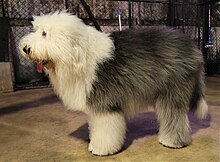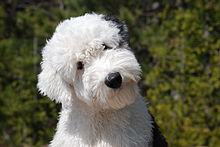This is an old revision of this page, as edited by Tallbobert (talk | contribs) at 23:23, 22 July 2023 (→See also: Removed underscore from link to The Shaggy Dog, as an underscore is not used in the article title.). The present address (URL) is a permanent link to this revision, which may differ significantly from the current revision.
Revision as of 23:23, 22 July 2023 by Tallbobert (talk | contribs) (→See also: Removed underscore from link to The Shaggy Dog, as an underscore is not used in the article title.)(diff) ← Previous revision | Latest revision (diff) | Newer revision → (diff)
| This article needs additional citations for verification. Please help improve this article by adding citations to reliable sources. Unsourced material may be challenged and removed. Find sources: "Old English Sheepdog" – news · newspapers · books · scholar · JSTOR (July 2012) (Learn how and when to remove this message) |
| Old English Sheepdog | |||||||||||||||||||||||||
|---|---|---|---|---|---|---|---|---|---|---|---|---|---|---|---|---|---|---|---|---|---|---|---|---|---|
 A show-standard Old English Sheepdog A show-standard Old English Sheepdog | |||||||||||||||||||||||||
| Origin | England | ||||||||||||||||||||||||
| |||||||||||||||||||||||||
| |||||||||||||||||||||||||
| Dog (domestic dog) | |||||||||||||||||||||||||
The Old English Sheepdog is a large breed of dog that emerged in England from early types of herding dog. Obsolete names for the breed include Shepherd's Dog and bob-tailed sheep-dog. The nickname Bob-tail (or Bobtail) originates from how dogs of the breed traditionally had their tails docked. Old English Sheepdogs can grow very long coats with fur covering the face and eyes and do not shed unless brushed.
Appearance
The Old English Sheepdog is a large dog, immediately recognizable by its long, thick, shaggy grey and white coat, with fur covering their face and eyes. The ears lie flat to the head. Historically, the breed's tail was commonly docked (resulting in a panda bear–like rear end), but tailed Old English sheepdogs are now common, as many countries have outlawed cosmetic docking. When the dog has a tail, it has long fur (feathering), is low set, and normally hangs down. The Old English Sheepdog stands lower at the shoulder than at the loin, and walks with a "bear-like roll from the rear".
Height at the withers is at least 61 cm (24 in), with females slightly smaller than males. The body is short and compact, and ideal weights are not specified in the breed standards, but may be as much as 46 kg (101 lb) for large males.
Colour of the double coat may be any shade of grey, grizzle, black, blue, or blue merle, with optional white markings. The undercoat is water resistant. Puppies are born with a black and white coat, and it is only after the puppy coat has been shed that the more common grey or silver shaggy hair appears. Old English Sheepdogs only shed when they are brushed.
Docking
Undocked Old English Sheepdogs are becoming a more common sight as many countries have now banned docking. The Kennel Club (UK) and The Australian National Kennel Council breed standards do not express a preference for (legally) docked or un-docked animals, and either can be shown. The American Kennel Club breed standard states that the tail should be "docked close to the body, when not naturally bob tailed", even though the practice of cosmetic docking is now opposed by the American Veterinary Medical Association. It is believed that the practice of tail docking came about in the 18th century as a result of taxation laws that required working dogs to be docked as evidence of their working status, but nowadays, in places where the practice is still legal, tail docking is mainly performed for purely cosmetic reasons.
History

The Old English Sheepdog comes from the pastoral type dogs of England. A small drop-eared dog seen in a 1771 painting by Gainsborough is believed by some to represent the early type of the Old English Sheepdog. In the early 19th century a bobtailed drovers dog, called the Smithfield or Cotswold Cor, was noticed in the southwestern counties of England and may have been an ancestor. Most fanciers agree that the Bearded Collie was among the original stock used in developing today's breed. Some speculate that the Russian Owtchar was among the breed's ancestors.
The Old English Sheepdog was at first called the "Shepherd's Dog" and was exhibited for the first time at a show in Birmingham, England, in 1873. There were only three entries, and the judge felt the quality of the dogs was so poor that he offered only a second placing. From that beginning, the breed became a popular show dog, and, although the shape of the dog itself has changed very little over the years, elaborate grooming including backcombing and powdering the fur was recorded as early as 1907. The breed was exported to the United States in the 1880s, and by the turn of the 20th century, five of the ten wealthiest American families bred and showed the Old English Sheepdog. The breed continues to be a popular show dog today.
The best recent finish of an Old English Sheepdog at the Westminster Kennel Club dog show was in 2013 when Bugaboo's Picture Perfect was awarded Reserve Best in Show.
Health
US and UK surveys put the average lifespan of the Old English Sheepdog at 12–15 years. The Old English Sheepdog Club of America sponsors investigations into diseases encountered in the breed in order to assist breeders in selecting healthy dogs for breeding, and breeders of Old English Sheepdogs who are members of the Old English Sheepdog Club of America must support its Code of Ethics in breeding and selling sheepdogs. Some diseases being investigated include hip dysplasia, cataracts, glaucoma, entropion, thyroid problems, deafness, diabetes, HD, PRA, allergies and skin problems. There is no data on how many dogs are affected, or what percent of the breed is affected by any of these ailments. Heatstroke is also a serious concern in full coated dogs. Cancer is a major cause of death amongst Old English Sheepdogs.
Temperament
The breed standards describe the ideal Old English Sheepdog as never being nervous or aggressive. The New Zealand Kennel Club adds that "they are sometimes couch potatoes" and "may even try to herd children by gently bumping them." This breed's temperament can be described as intelligent, social and adaptable. The American Kennel Club adds that the breed has "a clownish energy" and "may try to herd people or other objects."
With wide open spaces being the ideal setting for an Old English Sheepdog, the breed is a natural fit in a rural setting, such as working on a farm; although, with proper exercise and training, they are perfectly comfortable with a suburban or urban lifestyle. Old English Sheepdogs should not be deprived of the company and the warmth of people.
Activities
The Old English Sheepdog can compete in dog agility trials, obedience, Rally obedience, Schutzhund, showmanship, flyball, tracking, and herding events. Herding instincts and trainability can be measured at noncompetitive herding tests. Old English Sheepdogs that exhibit basic herding instincts can be trained to compete in herding trials.
Coat care

The Old English Sheepdog's long coat requires a thorough brushing at least once weekly, which may take one to three hours. Without regular care, the coat can become "a trap for dust, debris, fecal matter, urine and moisture." Matting may become painful to the animal, such as in between the toes, and can restrict movement in severe cases. Prospective owners may be deterred by the level of care required if long hair is desired.
The preferred method of grooming involves starting from the base of the hairs to keep the thick undercoat hair mat- and tangle-free. The brushing should be started at a very young age to get the dog used to it. A hairband may be used to keep a dog's fur out of its eyes. Many people trim their dogs' coats to a more manageable length. A professional quality electric shear reduces time spent trimming. However, dogs that are being shown in conformation must retain their natural coat.
Some people shave their Sheepdog's hair and spin it into yarn.
Dulux dog

The Old English Sheepdog is the brand mascot for Dulux paint. The dog was first introduced in advertising campaigns in 1961. Since then they have been a constant and highly popular feature of Dulux television and print adverts wherever the paint is sold. So much so, that many people in those markets refer to the breed as a 'Dulux dog' rather than a Sheepdog.
Over the years, different dogs have appeared in the adverts. However, they all look very similar, due to the carefully managed selection process carried out by ICI's advertising agency. The first Dulux dog was Shepton Daphnis Horsa, pet name Dash, who held the role for eight years, owned by Eva Sharp in Tottenham. His successor, Fernville Lord Digby, was the most famous Dulux dog and also made his owners, Cynthia and Norman Harrison, famous.
When filming advertisements, Digby was treated like a star, being driven to the studio in a chauffeur driven car. Barbara Woodhouse was employed to train Digby and his three stunt doubles, who were used whenever specific tricks or actions needed to be filmed. Digby's popularity led him to play the title role in the 1973 British comedy film Digby, the Biggest Dog in the World.
Gambit - another Dulux dog, was used in a photographic shoot in 1980 for Philips Video and its new generation of video recorders. By the time the shoot was finished, there was enough hair to fill a mattress - the dog was constantly groomed during the shoot. King Hotspur of Amblegait was used from 1974 to 1979 and appeared in over fifty television programmes as well as his public appearances for ICI/Dulux.
Apart from Dash, all the Dulux dogs have been breed champions, and five of them have won 'Best in Show' prizes.
The Dulux dog was placed at No. 51 in Channel 4's "100 Greatest Television Adverts".
See also
- Dogs portal
- List of dog breeds
- The Shaggy Dog (1959 film)
- Mr. Mugs
- "Martha My Dear", Beatles' song about Paul McCartney's Old English Sheepdog
References
- ^ "History of the Old English Sheepdog". oldenglishsheepdogclubofamerica.org.
- Barton, Frank Townend (1908). "The Siamese—Abyssinian—Manx". The Cat: Its Points and Management in Health and Disease. London, England: Everett & Co. p. 31. Retrieved 18 November 2011.
- Fédération Cynologique Internationale Breed Standard
- "Canadian kennel Club breed standard". Ckc.ca. Retrieved 9 April 2014.
- ^ "The Kennel Club". thekennelclub.org.uk.
- "PetPlanet Breed Info". Petplanet.co.uk. Retrieved 9 April 2014.
- ^ "American Kennel Club Breed Standard". Akc.org. Archived from the original on 9 February 2015. Retrieved 9 April 2014.
- "Australian National Kennel Council breed standard". Ankc.org.au. 21 November 2012. Archived from the original on 26 May 2013. Retrieved 9 April 2014.
- AVMA.org Archived 25 January 2010 at the Wayback Machine
- Greater London Old English Sheepdog Club Breed History Archived 3 December 2008 at the Wayback Machine
- ^ Clark, Anne Rogers; Andrew H. Brace (1995). The International Encyclopedia of Dogs. Howell Book House. pp. 326–328. ISBN 0-87605-624-9.
- "Dog Longevity by Dr. Kelly M. Cassidy, 2007". Users.pullman.com. Retrieved 9 April 2014.
- "Old English Sheepdog Club Of America 2009 Breed Health Survey Report" (PDF). Archived from the original (PDF) on 2 July 2013. Retrieved 27 June 2012.
- "Individual Breed Results for Purebred Dog Health Survey". Archived from the original on 13 August 2013. Retrieved 27 June 2012.
- ^ "Buying and Owning an Old English Sheepdog". oldenglishsheepdogclubofamerica.org.
- The Old English Sheepdog, by Kim D. R. Dearth, Dog World Magazine, March 2001 online Archived 22 August 2009 at the Wayback Machine
- "Old English Sheepdog Club of America Health Website". Oeshealth.org. Retrieved 9 April 2014.
- "NZKC - Breed Standard - OLD ENGLISH SHEEPDOG". nzkc.org.nz.
- Hartnagle-Taylor, Jeanne Joy; Taylor, Ty (2010). Stockdog Savvy. Alpine Publications. ISBN 978-1-57779-106-5.